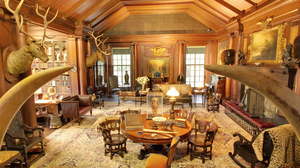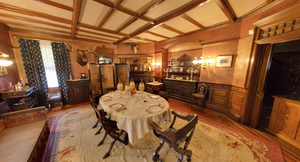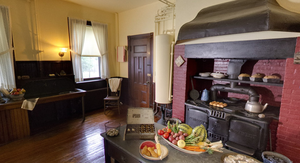Sagamore Hill is the historic former home of the 26th President of the United States, Theodore "Teddy" Roosevelt (1858-1919). Nicknamed the "Summer White House", it is located in the present day Village of Cove Neck, and was the president's home from 1885 until his death. The Queen Anne Victorian style house was constructed in 1884, and consists of three stories as well as approximately 14,175 square feet. The National Historic Site is currently open for tours, reserved in advance, from 10 am until 2 pm. Tickets are available at: https://www.recreation.gov/ticket/facility/251573?tab=tours
Born and raised in New York City, Teddy Roosevelt was first introduced to Oyster Bay as a child, where his family spent many summers together. During these vacations, he developed a love for the nature of the area, and would spend many occasions hiking, swimming, and horseback riding around the area. In 1880, at the age of 22, Roosevelt and his wife Alice bought a 155 acre parcel of farmland where Sagamore Hill is located today. Soon after, the pair hired the architectural firm Lamb & Rich to design a Queen Anne Victorian style home that would be both sturdy as well as modern. Builders John Wood and Son were hired to construct the couple's dream home, and construction began in 1884. Originally, the home was to be named "Leeholm", in honor of Roosevelt's wife Alice Lee. Shortly after construction started, however, sudden tragedy struck as Alice died while giving birth to the couple's first child. As Roosevelt was devastated from this event, he decided to change the name to its present day name of Sagamore Hill, after the Algonquin word for "Chieftain". As construction continued, Roosevelt decided to escape for the time by purchasing and moving to a cattle ranch in North Dakota, where he could ease the suffering of losing his wife with his love for the outdoors and nature. Construction of the house was finished in 1886, and around this time, Roosevelt married Edith Kermit Carow. They celebrated their honeymoon by moving into the newly built Sagamore Hill.
Over the next few years, Sagamore Hill would play a vital role in the president's life, and he and his wife would raise six children in the home. During his time in the White House, from 1901 until 1908, the home took on a new role as the "Summer White House" and a place where the president would spend much of his time writing speeches, hosting meetings, and inviting officials from around the nation and the world. Numerous events occurred here during this time, including peace talks to end the Russo-Japanese War.
After returning from the White House in 1908, President Roosevelt would spent the rest of his years living at Sagamore Hill. On the last day of his life in 1919, the president was caught by his wife staring out one of the windows, and said to her, "I wonder if you know how much I love Sagamore Hill". Edith would occupy the home for the next 29 years until her death in 1948, after which the home was purchased by the Theodore Roosevelt Association. In 1953, the home was opened to the public, and in 1962 was bought by its current owner, the National Park Service.
Sagamore Hill consists of 23 rooms and three stories . The first story consists of the entrance hall, library, drawing room, kitchen, dining room, pantry, and the North Room which was added in 1905. The second story of the house consists of living quarters that the Roosevelts and their six children used. The third floor housed the trunk room, linen closet, school room, gun room, maids' bedrooms, and a bedroom that the president's son Theodore Jr. would occupy later in his life. The house is preserved today as it was when the president lived there. As Theodore was an avid hunter, taxidermist, and outdoorsman throughout is life, the house is furnished with many of his hunting trophies.
The front hall is the first room in the house. Roosevelt would often introduce guests himself as they entered the home, and prior to the North Room's completion in 1905, the hall was set up as a sitting room with several chairs and a couch near the fireplace. Often the family would leave tennis rackets and balls on the mantle of the fireplace for easy access in the event of a pickup game.
The library, one of the most important rooms to the president, is located to the right of the entrance hall. The room was described by the president's daughter Edith to be the "heart of the home", as the family would gather here and spend a great deal of time together. During Roosevelt's presidency, the room took on even more importance, as the president would meet every day here with his staffers to learn about current events, come up with speeches, and review new legislation. The library is also where Roosevelt would hold meetings with several cabinet members and foreign diplomats. The library is said to have 8,000 books, and the walls are lined with several paintings of Roosevelt's heroes, including George Washington, Abraham Lincoln, and his father.
The drawing room was the first lady, Edith's personal room and private office. Though many guests were welcomed in this room, Edith used the room to manage the family's finances and investments, as well as spend time reading, writing letters, or having tea with friends.
The north room was added to the home in 1905 in order to have a larger, dedicated space for the president's many guests and visitors. The room would come to be a space for the family as well, as it would host several parties and holiday celebrations. The room contains several personal and family furnishings as well as presidential gifts and hunting trophies. The elephant tusks at the room's entrance, for example, were gifted to the president by Emperor Menelik II of Ethiopia as a sign of friendship in 1903.
The dining room was where meals were held, always in a formal manner. During meals, servers would be located behind the screen located to the right, and Edith would sit in the chair closest to them in order to tell them if the guests needed anything. Frequently, the president's children would eat alongside the president's guests, and would listen in on the numerous important conversations that would take place regarding politics and foreign affairs.
The kitchen was frequented by the home's several servants as well as Edith, who would meet with the staff to plan meals and menus. Lunch was often the most fast-paced meal of the day for the kitchen staff; breakfast and dinnertime were reserved only for the family or those closest to the family, and lunch was when the president would meet with other guests. A great deal of the food cooked in this kitchen came from the farm that was located on the property. The farm grew several varieties of fruits, such as cherries, apples, and pears, included a flock of chickens as well as turkeys and pigs, and had a herd of dairy cows.
References:
Christiansen, M. (2015, July 7). Theodore Roosevelt House Rehabilitation Project Completed. - Sagamore Hill National Historic Site (U.S. National Park Service). National Park Service. Retrieved November 14, 2021, from https://www.nps.gov/sahi/learn/news/rehabilitation-project-completed.htm
Maranzani, B. (2020, May 19). What Theodore Roosevelt’s Sagamore Hill Home Reveals About His Personality. Biography. Retrieved November 14, 2021, from https://www.biography.com/news/theodore-roosevelt-sagamore-hill-home
Menelik II, Menelik II.: , (1903, December 17). Translation of letter from Emperor Menelik II to Theodore Roosevelt. Theodore Roosevelt Papers. Library of Congress Manuscript Division.
Retrieved from https://www.theodorerooseveltcenter.org/Research/Digital-Library/Record?libID=o43319.
National Park Foundation. (n.d.). Sagamore Hill National Historic Site. Retrieved November 14, 2021, from https://www.nationalparks.org/connect/explore-parks/sagamore-hill-national-historic-site
National Park Service. (n.d.). Sagamore Hill National Historic Site (U.S. National Park Service). Retrieved November 14, 2021, from https://www.nps.gov/sahi/index.htm
National Park Service. (2015, February 26). History & Culture - Sagamore Hill National Historic Site (U.S. National Park Service). Retrieved November 14, 2021, from https://www.nps.gov/sahi/learn/historyculture/index.htm
National Park Service. (2021). Theodore Roosevelt Home, Sagamore Hill. Google Arts & Culture. Retrieved November 14, 2021, from https://artsandculture.google.com/exhibit/theodore-roosevelt-home-sagamore-hill/cwKShL06r9X2Kg
Rather, J. (1985, November 17). L.I.’S PLACE IN JAPAN’S PAST. The New York Times. Retrieved November 14, 2021, from https://www.nytimes.com/1985/11/17/nyregion/li-s-place-in-japan-s-past.html
Theodore Roosevelt Center at Dickinson State University. (n.d.). TR Center - Sagamore Hill. Theodore Roosevelt Center. Retrieved November 14, 2021, from https://www.theodorerooseveltcenter.org/Learn-About-TR/TR-Encyclopedia/Family-and-Friends/Sagamore-Hill









